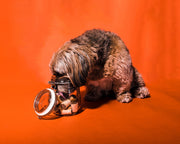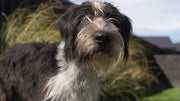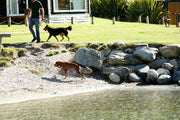
Trick or Treat? What's really in those dog snacks?
Less is more when it comes to ingredient lists on food products — and this goes for dog treats too.
In recent years, health conscious shoppers have become accustomed to turning packets over in the supermarket and checking for unrecognisable and often unreadable names, indicating nasty preservatives and additives. Dog owners should do the same with treat products. Just like humans, dogs benefit from whole foods and natural ingredients. Here’s what to look for and avoid, to keep your pup healthy and happy at treat time.
Preservatives
Look for those that contain natural preservatives like Vitamin C or Vitamin E, or that are made with cured or dried meat that doesn’t require a preservative. Some dried meat treats (ahem, the Topflite Hound range) have singular ingredient lists – the meat and nothing but the meat. These are best if you want to avoid preservatives.
If buying a product with preservatives, here are the ones you should especially steer clear from:
- BHA and BHT are both chemical preservatives that are considered to be carcinogens.
- Check for ethoxyquin, which can cause liver problems.
- Nitrates, MSG and propyl gallate, which can be toxic if ingested in large quantities.
- Carrageenan, which can cause gastrointestinal problems.
To avoid preservatives altogether, go for freeze-dried raw meat treats. The freeze-drying process removes around 99% of the moisture and eliminates the need for preservatives altogether. Best of all, the meat conserves 97% of its original nutritional value after being freeze-dried and they’re low in fat.
Meat meal
Food manufacturers use this term for scrap meat and waste products that have been heated to remove fat. This could mean waste from the slaughterhouse floor, outdated meats or even diseased animals. While it may contain protein, there is no telling what else it contains.
Generally, if a product says it contains meat, without defining the type of meat, it is best avoided. Remember that organ meats like beef tripe and liver are particularly nutrient dense (choose freeze-dried if the ick factor is too off-putting!)
Unhealthy fats and oils
While dogs need fats to fuel their zoomies, it is best to avoid the generic term ‘animal fat’, as like meat meal, this could mean anything. Instead, look for fish or salmon oil, or beef or chicken fat, as healthier fat alternatives straight from the source.
One to avoid for sure is propylene glycol, which is used to improve texture and extend shelf life but can trigger allergic reactions. Vegetable oils that are rich in omegas like flax and hemp seed oils are anti-inflammatory but others can do the opposite and actually trigger inflammation.
Food dyes
While coloured dog treats can look good to humans, dogs don’t really give a snoot what colour their treats are. In fact, the best dog treats are often those that look disgusting to us (think: pig ears).
Food colourings can cause your dog to become hyperactive and have even been shown to cause cancers, so it’s best to go for those with no colourings added at all.
Rule of thumb: keep it simple
Whether you use them as a training tool or just to reward your dog for being their good floofy self, most dog owners have some treats on hand. When buying yours, remember that the smaller the ingredient list, the better.
Related Products
Related Posts
Dogs of Topflite: introducing our good boys and girls
Behind every great Topflite team member, there's a very good boy or girl! Allow us to introduce a few of them to you....
Trick or Treat? What's really in those dog snacks?
Less is more when it comes to ingredient lists on food products — and this goes for dog treats too. In recent years, ...
Why chocolate is bad for dogs
Making the distressing discovery that your hound has been wolfing down the Whittakers is almost a rite of passage for...
New Zealand’s best dog-friendly cafes and bars
Where are the best places to dine with dogs around New Zealand? Recently we asked Hound fans to share their favour...
Are you set for a dog-friendly summer?
All the festivities and merry-making with your human friends means your canine ones sometimes get overlooked at this ...









